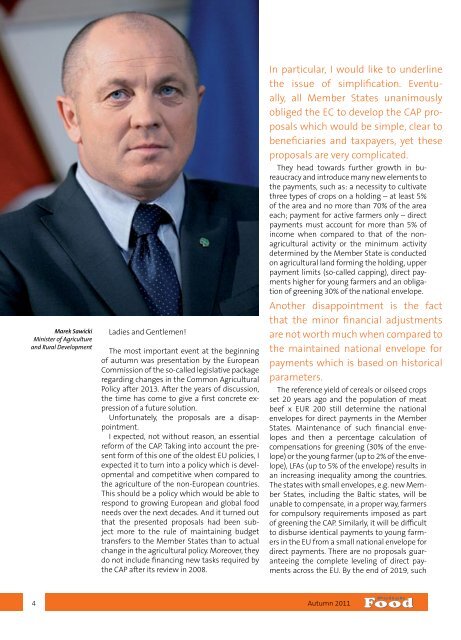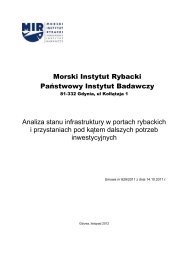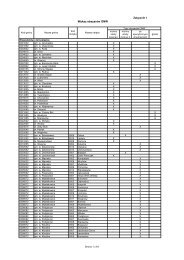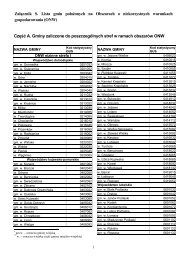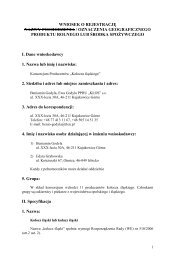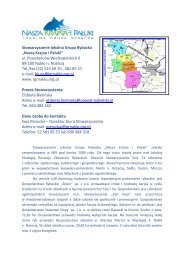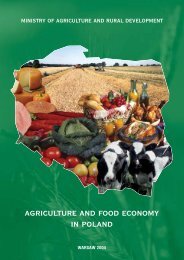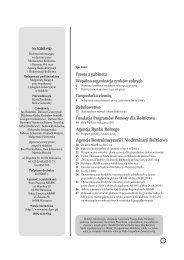download file
download file
download file
Create successful ePaper yourself
Turn your PDF publications into a flip-book with our unique Google optimized e-Paper software.
Marek Sawicki<br />
Minister of Agriculture<br />
and Rural Development<br />
Ladies and Gentlemen!<br />
The most important event at the beginning<br />
of autumn was presentation by the European<br />
Commission of the so-called legislative package<br />
regarding changes in the Common Agricultural<br />
Policy after 2013. After the years of discussion,<br />
the time has come to give a first concrete expression<br />
of a future solution.<br />
Unfortunately, the proposals are a disappointment.<br />
I expected, not without reason, an essential<br />
reform of the CAP. Taking into account the present<br />
form of this one of the oldest EU policies, I<br />
expected it to turn into a policy which is developmental<br />
and competitive when compared to<br />
the agriculture of the non-European countries.<br />
This should be a policy which would be able to<br />
respond to growing European and global food<br />
needs over the next decades. And it turned out<br />
that the presented proposals had been subject<br />
more to the rule of maintaining budget<br />
transfers to the Member States than to actual<br />
change in the agricultural policy. Moreover, they<br />
do not include financing new tasks required by<br />
the CAP after its review in 2008.<br />
In particular, I would like to underline<br />
the issue of simplification. Eventually,<br />
all Member States unanimously<br />
obliged the EC to develop the CAP proposals<br />
which would be simple, clear to<br />
beneficiaries and taxpayers, yet these<br />
proposals are very complicated.<br />
They head towards further growth in bureaucracy<br />
and introduce many new elements to<br />
the payments, such as: a necessity to cultivate<br />
three types of crops on a holding – at least 5%<br />
of the area and no more than 70% of the area<br />
each; payment for active farmers only – direct<br />
payments must account for more than 5% of<br />
income when compared to that of the nonagricultural<br />
activity or the minimum activity<br />
determined by the Member State is conducted<br />
on agricultural land forming the holding, upper<br />
payment limits (so-called capping), direct payments<br />
higher for young farmers and an obligation<br />
of greening 30% of the national envelope.<br />
Another disappointment is the fact<br />
that the minor financial adjustments<br />
are not worth much when compared to<br />
the maintained national envelope for<br />
payments which is based on historical<br />
parameters.<br />
The reference yield of cereals or oilseed crops<br />
set 20 years ago and the population of meat<br />
beef x EUR 200 still determine the national<br />
envelopes for direct payments in the Member<br />
States. Maintenance of such financial envelopes<br />
and then a percentage calculation of<br />
compensations for greening (30% of the envelope)<br />
or the young farmer (up to 2% of the envelope),<br />
LFAs (up to 5% of the envelope) results in<br />
an increasing inequality among the countries.<br />
The states with small envelopes, e.g. new Member<br />
States, including the Baltic states, will be<br />
unable to compensate, in a proper way, farmers<br />
for compulsory requirements imposed as part<br />
of greening the CAP. Similarly, it will be difficult<br />
to disburse identical payments to young farmers<br />
in the EU from a small national envelope for<br />
direct payments. There are no proposals guaranteeing<br />
the complete leveling of direct payments<br />
across the EU. By the end of 2019, such<br />
4<br />
Autumn 2011


